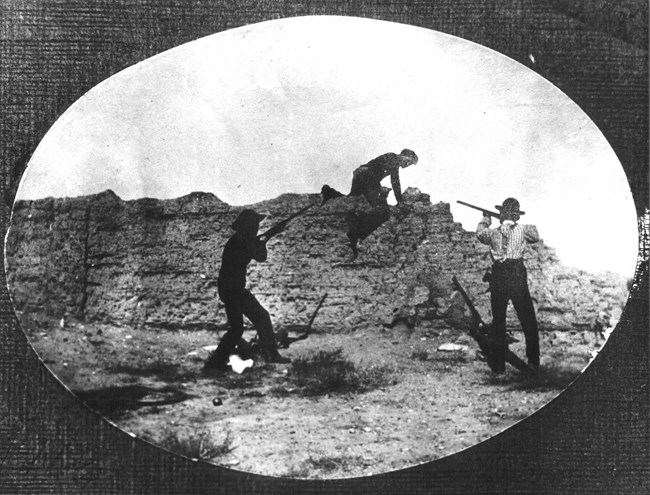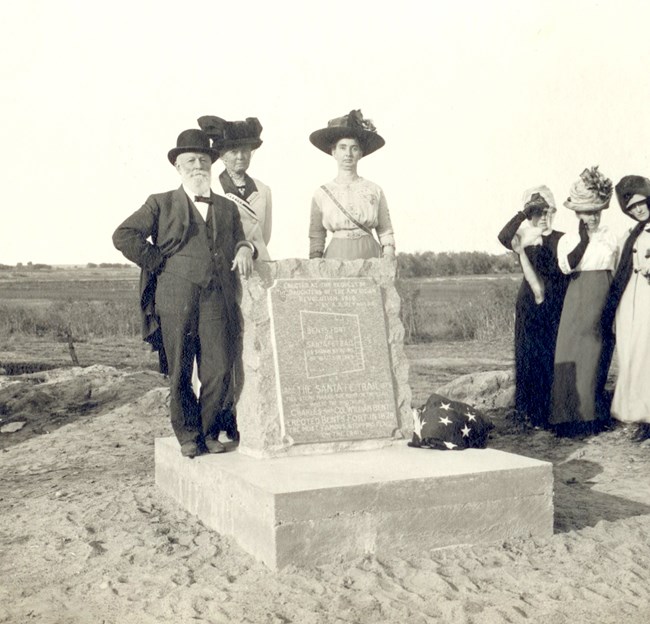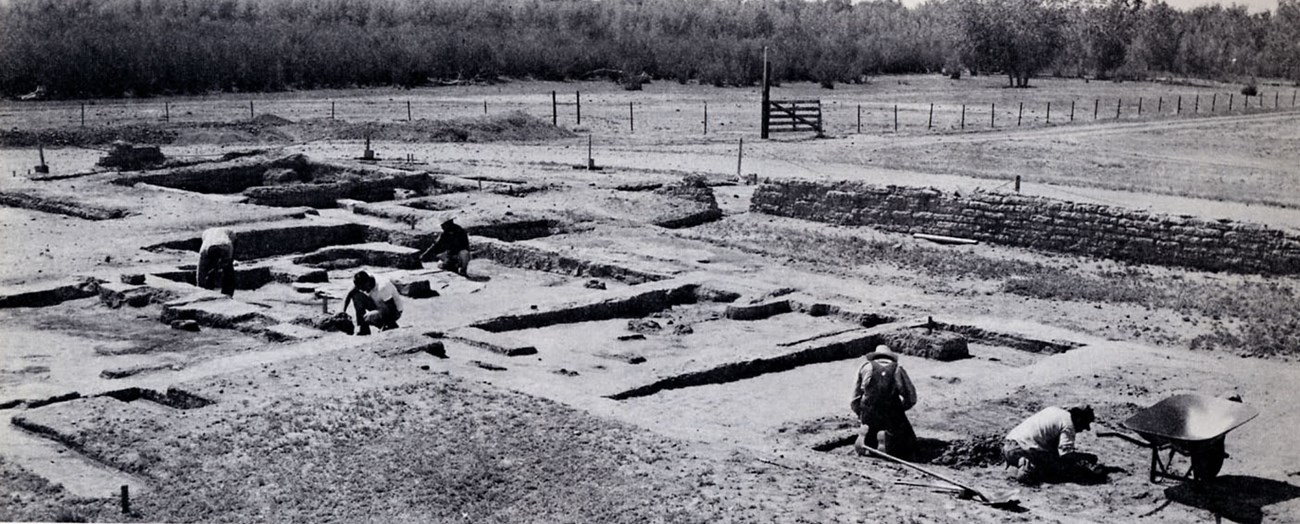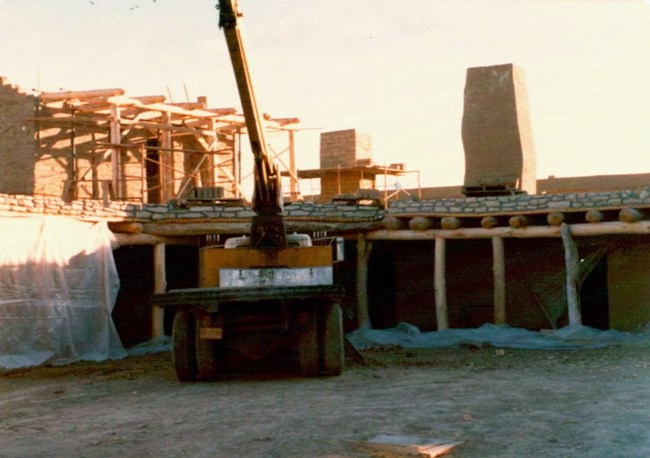Last updated: May 3, 2024
Article
Reconstructing the Castle on the Plains
Bent’s Old Fort was completely reconstructed by the National Park Service as a bicentennial project and was dedicated on July 25, 1976. The state of Colorado strongly supported the reconstruction of the fort, as 1976 also marked the centennial of Colorado's statehood. The dual celebration was especially appropriate since this legendary trading post is considered the first Anglo-American settlement in Colorado, besides playing a pivotal role in the early history of the American Southwest. The large scale of the reconstruction was unique way to mark America's 200th birthday and stands today as a reminder of how the United States has remembered its past.

NPS Photo
After the Bents
The original fort was constructed beginning in 1833 and was the largest of all trading posts in the mountain plains region. It was abandoned and partially destroyed, probably by its owner William Bent, sometime in August 1849 after cholera ravaged the plains. However, much of the structure did survive. Beginning in 1861 and continuing into the early 1870s, the remaining walls were utilized as a stagecoach station and a post office. When a new stage line from Denver to Santa Fe bypassed the old fort, the stagecoach era ended.Julia Bent, daughter of William Bent and his first wife, a Cheyenne named Owl Woman, received legal title to the property in 1870 as result of the Treaty of the Little Arkansas, which gave sections of land to mixed-blood children of white and Indian marriages. She lived at the post briefly in 1872 before selling the property to cattleman John Prowers later that year. Julia Bent was the building’s last connection to William Bent. Prowers used the post as a line camp and cattle stockade.
During the 1880s, settlers along the Arkansas Valley hauled away most of the remaining bricks and timbers by the wagonload to build homes and barns. By 1900, the fort was reduced to a pile of rubble.

NPS Photo
The Road to Reconstruction
The road to reconstruction began in 1912 when the La Junta Chapter of the Daughters of the American Revolution erected a marker that still stands near the site’s entrance. In 1920, the D.A.R. was given some 4.5 acres containing the fort ruins from a farm then owned by A. E. Reynolds, an elderly Colorado pioneer and entrepreneur. The D.A.R. is credited for not only preserving the site but for putting forth the first idea of some form of reconstruction.
The State of Colorado purchased the land for the use and benefit of the Colorado Historical Society on June 14, 1954. The society took further steps toward reconstruction by hiring Professor Herbert W. Dick of Trinidad State Junior College to do an archeological investigation of the site. Forty-two days of digging were undertaken in the summer of 1954. Beyond that, state funding for reconstruction never materialized.
By 1957 thinking began to turn to possible NPS involvement. The NPS quickly recognized the site’s importance relative to the theme of westward expansion. Feasibility studies soon followed. President Dwight D. Eisenhower signed legislation authorizing the establishment of Bent's Old Fort as a unit of the National Park System on June 1, 1960.

NPS photo
Questions of Research and Preservation
Intensive research became the first priority for the NPS. Historian Dwight E. Stinson, Jr. began searching for diaries and journals left by eyewitnesses of the old trading post. In addition to finding more than 20 written accounts, Stinson found pen and ink drawings and watercolor paintings of the fort, completed in 1845 and 1846 by United States Army Topographical Engineer Lt. James Abert. Abert’s work provided measured drawings that provided critical information needed for reconstruction.
Jackson W. Moore was hired to do a second archeological excavation in 1963. Moore supervised a three-year excavation that revealed the layout of the fort and determined the most likely use of each ground floor room. Some 35,000 artifacts were unearthed. The dig provided another critical portion of necessary information to rebuild. Conjecture and common sense provided the rest.
A four-man, blue-ribbon committee from within the ranks of the NPS was formed in 1965 to decide whether or not to rebuild—as a definite decision had yet to be made. The panel split down the middle for and against reconstruction. Objections centered around the obliteration of existing remains and the idea of a reconstruction based largely on conjecture. Eventually a decision was reached favoring a fulls scale reconstruction of the fort.

NPS Photo
Reconstruction
The process leading to reconstruction was begun with historical research and archaeological excavation in 1963. Dwight Stinson, NPS Historian, completed a comprehensive history data section of the structure 1966. This document, along with the archeological report, provided the research base for the preparation of construction documents.
Although complicated by the divergent reports of eyewitnesses, some very obvious errors and fabrications, and, of-course, the many breaks in records, the historical data provided roughly thirty percent of the necessary information. The archaeological report provided another thirty percent of the needed information for reconstruction. The remaining forty percent of the design had to be entirely based on conjecture.
Construction began on May 27, 1975. Clay, sand, straw and water were mixed by front-loading tractors in a 30 by 50 foot pit. A custom-built machine capable of producing 4,000 bricks per day was used to make 160,000 adobe blocks, each measuring 4 by 9 by 18 inches. Instead of the standard practice of laying adobe bricks on the ground, a concrete foundation was poured to protect the walls from the leaching of rain and ground water. Concrete, foam, and sand were poured for the floors under a surface of packed adobe to provide similar protection. Considerable redesign of the Fort construction methods and materials occurred during construction.
Skilled craftsmen, knowledgeable in ancient woodworking techniques, hand cut 800 cottonwood trees to provide timbers for the massive vigas that support the fort’s roof. Over 112,000 linear feet of ponderosa pine were used to provide the smaller latias. Wood was fashioned by hand for doors and windowsills, while two blacksmiths produced several hundred pieces of hardware inside a reconstructed blacksmith shop.
Constructed of earth, wood, and iron from the blacksmith’s fire, the fort stands today as one of our nation’s most unique, educational, architectural, and historical exhibits.
